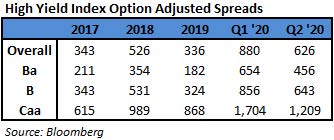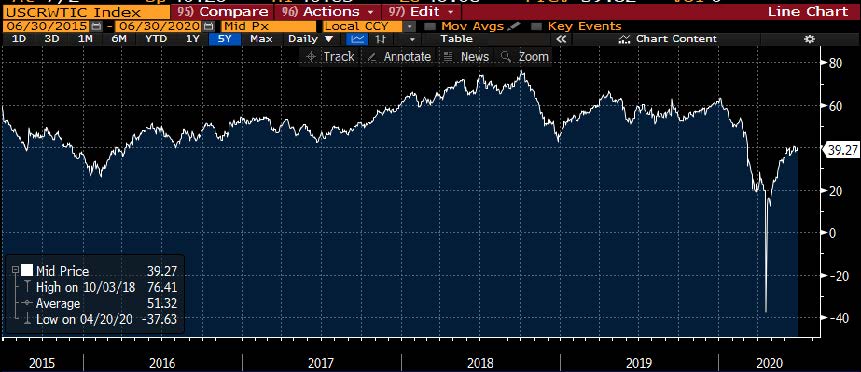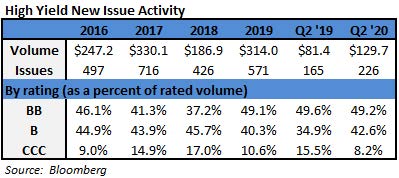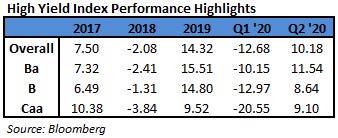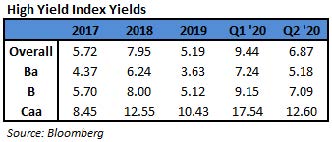2020 Q2 High Yield Quarterly
In the second quarter of 2020, the Bloomberg Barclays US Corporate High Yield Index (“Index”) return was 10.18% bringing the year to date (“YTD”) return to -3.80%. The CAM High Yield Composite gross total return for the second quarter was 9.06% bringing the YTD return to -1.87%. The S&P 500 stock index return was 20.54% (including dividends reinvested) for Q2, and the YTD return stands at -3.09%. The 10 year US Treasury rate (“10 year”) was fairly subdued during the quarter finishing at 0.66%, down 0.01% from the beginning of the quarter. This is up from the record low of 0.54% posted in early March. During the quarter, the Index option adjusted spread (“OAS”) tightened 254 basis points moving from 880 basis points to 626 basis points. During the second quarter, each quality segment of the High Yield Market participated in the spread tightening as BB rated securities tightened 198 basis points, B rated securities tightened 213 basis points, and CCC rated securities tightened 495 basis points. Take a look at the chart below from Bloomberg to see a visual of the spread moves in the Index over the past five years. The graph really shows the speed of the spread move in both directions during 2020.
The Energy, Other Industrial, and Banking sectors were the best performers during the quarter, posting returns of 40.02%, 11.57%, and 10.77%, respectively. On the other hand, Transportation, Communications, and Utilities were the worst performing sectors, posting returns of -5.71%, 4.64%, and 5.47%, respectively. At the industry level, independent energy, midstream energy, oil field services, autos, and gaming all posted the best returns. The independent energy industry (48.69%) posted the highest return. The lowest performing industries during the quarter were airlines, transportation services, aerospace/defense, cable, and leisure. The airline industry (-14.88%) posted the lowest return.
The movement in the energy market was a major theme during the quarter. The energy sector bounce in the second quarter was a welcome sign after a disastrous first quarter punctuated by a Russia/Saudi dispute. A record move in the price of oil can be added to the list of records being made in 2020. In April, the front month oil futures contract actually went negative to the tune of -$37.63 per barrel. Naturally, this was more of a technical event and was unsustainable. The price was able to quickly move above the zero line and finished at just over $10 per barrel the very next day. Further improvements in the price throughout the rest of the quarter were helped by a Russia/Saudi agreement, Saudi making additional output cuts, a further OPEC extension of output cuts, and the reopening of economies after shutdowns.
During the second quarter, the high yield primary market posted a massive $129.7 billion in issuance. Many companies took advantage of the open new issue market to boost liquidity in order to navigate the pandemic. Issuance within Consumer Discretionary was the strongest with approximately 32% of the total during the quarter. The opening of the market was very encouraging to see after being effectively closed during the month of March. While we expect the issuance door to remain open, it is likely that the pace will slow during the third quarter of the year.
The Federal Reserve remained active during the quarter. They maintained the Target Rate to an upper bound of 0.25% at both the April and June meetings with all ten voting members approving. In mid-May the Fed started purchasing ETFs under their SMCCF program. Subsequently, the Fed made the decision to pivot from buying ETFs to buying individual corporate bonds.i This pivot does allow the Fed the ability to be more targeted in their impact. The individual bond purchases got under way during the third week of June. Therefore, there isn’t a lot of data available yet, but the Fed has accumulated $8.7 billion in corporate debt within a $9.6 trillion corporate debt market. The biggest takeaway is the Fed is watching the debt markets closely, and they are at the ready to continue supporting the market. Chairman Powell testified before Congress and stated “we feel the need to follow through and do what we said we’re going to do.”ii
Intermediate Treasuries decreased 1 basis point over the quarter, as the 10-year Treasury yield was at 0.67% on March 31st, and 0.66% at the end of the quarter. The 5-year Treasury decreased 9 basis points over the quarter, moving from 0.38% on March 31st, to 0.29% at the end of the quarter. Intermediate term yields more often reflect GDP and expectations for future economic growth and inflation rather than actions taken by the FOMC to adjust the Target Rate. There is no doubt that economic reports are going to be quite noisy over the balance of 2020. However, the revised first quarter GDP print was -5.0% (quarter over quarter annualized rate), and the current consensus view of economists suggests a GDP for 2020 around -5.6% with inflation expectations around 0.8%.
Being a more conservative asset manager, Cincinnati Asset Management is structurally underweight CCC and lower rated securities. This positioning has served our clients well over the first half of 2020. As noted above, our High Yield Composite gross total return has outperformed the Index over the year to date measurement period. With the market so strong during the second quarter, our cash position was a drag on our overall performance. Additionally, the energy sector was a drag on our performance. Our credit selections within the energy sector had very strong returns. However, we maintained a quality focus in the sector and that left our credits trailing the broader energy sector. Alternatively, the communications sector was a benefit to overall performance. Our underweight positioning in the sector, as well as, our credit selections both contributed to the performance during the quarter. Finally, our credit selections within the consumer cyclical sector provided an overall benefit to performance.
The Bloomberg Barclays US Corporate High Yield Index ended the second quarter with a yield of 6.87%. This yield is an average that is barbelled by the CCC-rated cohort yielding 12.60% and a BB rated slice yielding 5.18%. Equity volatility, as measured by the Chicago Board Options Exchange Volatility Index (“VIX”), has come down nicely over the quarter to just above a reading of 30 from the March high of 83. For context, the average was 15 over the course of 2019. The second quarter had 26 issuers default on their debt. The trailing twelve month default rate was 6.19% and the energy sector accounts for almost half of the default volumeiii. This is up from the trailing twelve month default rate of 3.35% posted during the first quarter. Pre-Covid, fundamentals of high yield companies had been mostly good and will no doubt continue to be tested as we move through the second half of 2020. From a technical perspective, supply has been robust and fallen angels have added to the size of the high yield market. However, fund flows have been at record levels and the top 5 largest weekly fund flows on record all occurred during the quarteriv. High yield has certainly had trouble this year; however there has been a nice bounce during the second quarter and quality credits are performing as expected. For clients that have an investment horizon over a complete market cycle, high yield deserves to be considered in the portfolio allocation.
Even accounting for the rebound in the second quarter, the High Yield Market is still trading at elevated spread levels, and it is important that we exercise discipline and selectivity in our credit choices moving forward. We are very much on the lookout for any pitfalls as well as opportunities for our clients. The market needs to be carefully monitored to evaluate that the given compensation for the perceived level of risk remains appropriate on a security by security basis. It is important to focus on credit research and buy bonds of corporations that can withstand economic headwinds and also enjoy improved credit metrics in a stable to improving economy. As always, we will continue our search for value and adjust positions as we uncover compelling situations. Finally, we are very grateful for the trust placed in our team to manage your capital through such an unprecedented time.
This information is intended solely to report on investment strategies identified by Cincinnati Asset Management. Opinions and estimates offered constitute our judgment and are subject to change without notice, as are statements of financial market trends, which are based on current market conditions. This material is not intended as an offer or solicitation to buy, hold or sell any financial instrument. Fixed income securities may be sensitive to prevailing interest rates. When rates rise the value generally declines. Past performance is not a guarantee of future results. Gross of advisory fee performance does not reflect the deduction of investment advisory fees. Our advisory fees are disclosed in Form ADV Part 2A. Accounts managed through brokerage firm programs usually will include additional fees. Returns are calculated monthly in U.S. dollars and include reinvestment of dividends and interest. The index is unmanaged and does not take into account fees, expenses, and transaction costs. It is shown for comparative purposes and is based on information generally available to the public from sources believed to be reliable. No representation is made to its accuracy or completeness.
i JP Morgan June 29, 2020: “SMCCF Update”
ii Wall Street Journal June 28, 2020: “The central bank disclosed the names of 794 companies whose bonds it began purchasing this month
iii JP Morgan July 1, 2020: “Default Monitor”
iv JP Morgan July 1, 2020: “High Yield Bond Monitor”
